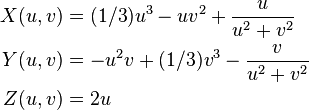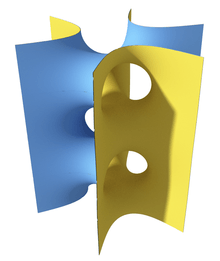Richmond surface

Richmond surface for m=2.
In differential geometry, a Richmond surface is a minimal surface first described by Herbert William Richmond in 1904. [1] It is a family of surfaces with one planar end and one Enneper surface-like self-intersecting end.
It has Weierstrass–Enneper parameterization  . This allows a parametrization based on a complex parameter as
. This allows a parametrization based on a complex parameter as
The associate family of the surface is just the surface rotated around the z-axis.
Taking m = 2 a real parametric expression becomes:[2]
References
- ↑ Jesse Douglas, Tibor Radó, The Problem of Plateau: A Tribute to Jesse Douglas & Tibor Radó, World Scientific, 1992 (p. 239-240)
- ↑ John Oprea, The Mathematics of Soap Films: Explorations With Maple, American Mathematical Soc., 2000
| ||||||||
This article is issued from Wikipedia - version of the 10/16/2015. The text is available under the Creative Commons Attribution/Share Alike but additional terms may apply for the media files.
![\begin{align}
X(z) &= \Re[(-1/2z) - z^{2m+1}/(4m+2)]\\
Y(z) &= \Re[(-i/2z) + i z^{2m+1}/(4m+2)]\\
Z(z) &= \Re[z^n / n]
\end{align}](../I/m/c73888e95f28f488ef95f2f7ae4800d4.png)

